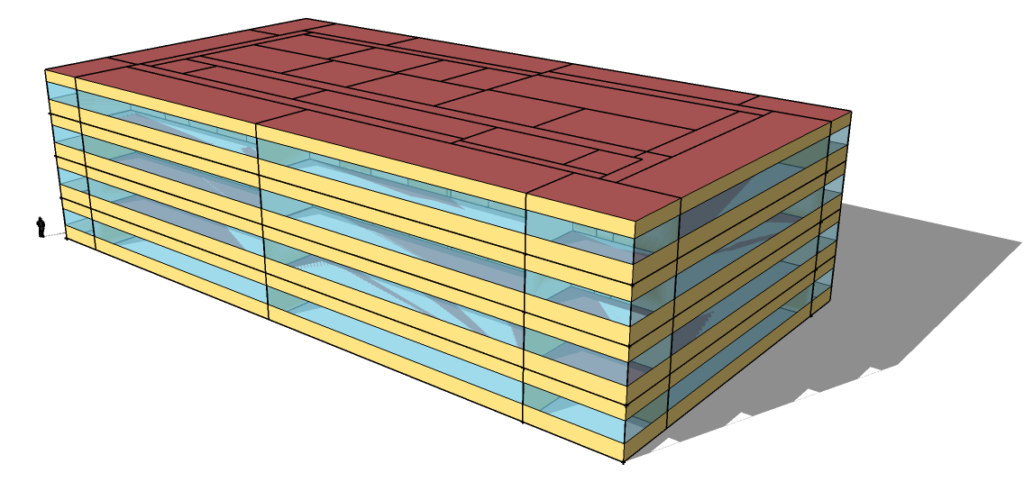
OpenStudio, the Energy Modeling Software We Need

Having used energy modeling software for years I believe the majority of tools used today are not preparing energy consultants for the future to come. Performance based energy estimates, such as predicting measurable energy use or net zero energy, require a skilled workforce with tools capable of simulating options as needed to be able to educate a team of designers on energy probabilities and to give direction quickly.
Today, most energy modeling tools take considerable shortcuts in modeling HVAC system performance and focus mostly on producing answers for comparative use, the basis for most energy standards. Perhaps this is the justification for the lack of development in today’s modeling software. However, other industries larger than the built environment, are rapidly moving toward ways of augmenting calculations, through integration of machine learning or comparison to big data sets, for better predictable results.
Many building owners today are starting to ask for better ways to anticipate performance, even if it requires engaging in a new range of inquiry about the key drivers of energy use. This presents a challenge to the way people are learning and using energy modeling tools today. I see building energy modeling becoming divided into those stuck with one set of tools and others taking the leap into newer software and integration with higher level programming.
Antiquated Energy Modeling Tools
On the short list are some of my old favorite tools I used (and made training videos!) for years: eQuest, Trane Trace, and EnergyPro (DOE2.1), and the newest CBECC-Com.
- eQuest, while free and easy, is likely the worst offender of the market. The software sets an artificial ceiling in speed and accuracy. I used it for years myself and continue to have YouTube videos on how to use some of the software features. While it is ‘fast to simulate’ it is incredibly limited in many other features. The software lacks any easy batch processing, scripting, and access to detailed hourly results. The larger challenge eQuest faces is the lack of HVAC freedom and a requirement to use pre-constructed ‘systems’. This workflow creates a culture of work-arounds for approximating engineering vs using algorithms created to match modern HVAC configurations.
- Trane Trace, while claimed to be updated with EnergyPlus, is almost stuck in the Stone Age by comparison to modern tools, in regard to work flows. The claim of a more detailed back end (with EnergyPlus) are nice, although without innovation on usability, and on the front end it plateaus quickly. The same work flow I used in 2008 for Trace is the same work flow presented today in 2019. Perhaps the crutch of load calculations for mechanical engineers is too convenient.
- The California bucket of code based software tools EnergyPro and CBECC-Com currently stand as silos of usage to document compliance. While EnergyPro can be used for more functions like LEED compliance it is by far one of the largest black boxes of “data-in numbers-out”. More times than I can count I have been burned by stress and unforeseen problems of using EnergyPro. It may be a fast go-to solution when time is short, though eventually a client or reviewer will ask for more detail and it will simply not be possible. It is my opinion that anything slightly unconventional in building systems simply should not be attempted in EnergyPro. And it begs the question, when a design is in early phases, should the energy modeling software really limit the options?
- CBECC-Com by the nature of what it was built for, Title 24 energy compliance, is also limited in what types of systems can be fully represented. This is the intent of Title 24 and the software has a process by which updates are made and new functionalities allowed. The interface and functional ways of changing inputs is quite challenging and very time consuming. Even if the intention was to ask for software developers to build on top of this software we are stuck using it as is today.
Modern Energy Modeling Tool Recommendations
Few tools have the right mix of scalability, accuracy, and detailed feedback for a user in my opinion. DesignBuilder, VE-IES, and OpenStudio are really all we have now. Of these, few have access to VE-IES and DesignBuilder. For me, OpenStudio was actually the gateway tool to both VE-IES and DesignBuilder.
Most of these are quite expensive relative to the free or cheap tools used (more than $2,000) and I found few employers (circa 2015) who understand the value of buying energy modeling software. For most energy modelers, the process to demonstrate this value becomes an internal business pitch. From experience in doing this I can say it pays to be able to demonstrate the benefit of using a software such as OpenStudio for the pitch, then buying a software like VE-IES or DesignBuilder.
Today, making a jump from the comfortable tools to any of the newer ones, energy modelers would do well to use OpenStudio as their gateway vehicle. In my opinion the only software close to unlocking new workflows and being able to transition most energy modelers to new levels of software use and integration.
- Without OpenStudio, my team would not have built advanced hydronic loops in EnergyPlus to configure true waterside economizing in early 2012.
- Without OpenStudio being semi-functional with Sketchup, I would not have been able to prove the value of EnergyPlus to convince my boss at the time to buy DesignBuilder in 2013.
- Without OpenStudio we would not have been able to scale the speed of our consulting in early conceptual stages by several factors, we never would have had the time to trial IES and upgrade a whole other division of services in better load calculations and robust LEED submissions.
- Without OpenStudio we never would have been able to drop eQuest out right and start teaching junior engineers how to model building physics and low energy HVAC instead of text edits and system work arounds.
OpenStudio software is more than a validation tool for other software providers. While some groups have weighed in favor of this tool being split in half and the front end basically discontinued by the DOE, in my opinion it should be maintained as is. The fact remains that the future is unknown. Yet, now is the time to think about the future of the built simulation environment and how it can be enhanced to support better buildings.
At present, if people do a majority of their current business work in LEED & energy code compliance, including Title 24, I would recommend using VE-IES as soon as possible. If your work spans into energy codes, market impact analysis, and multiple parametrics, OpenStudio is basically the only game in town. Learn the command line interface and parametric analysis tools provided.




